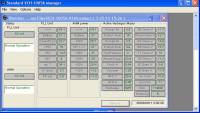User Tools
Sidebar
operations:checklist_parameters
This wiki is not maintained! Do not use this when setting up AuScope experiments!
This is an old revision of the document!
Checklist Parameter Descriptions
Below is an explanation of the current list of items to check during an observation:
- HMI: Antenna drives OK
Check the antenna status display in HMI on the Windows PC (to view it, start a VNC session via the Applications menu to time[hb|ke|yg]). If DRIVES STATUS, SOFT LIMITS, DEMAND LIMITING and HARD LIMITS are all green then all is well. If HMI isn't running or you want to restart it here are some notes on Starting HMI. - HMI: Time OK (i.e. SNTP server OK)
Check the antenna status display in HMI on the Windows PC (to view it, start a VNC session via the Applications menu to time[hb|ke|yg]). If the CURRENT TIME area reports SNTP SERVER OK, then the controller knows the time. If not, the antenna probably doesn't know where its pointing, there's a problem. If HMI isn't running or you want to restart it here are some notes on Starting HMI. - Antenna on source and tracking
In econtrol, typeonsourceand check the antenna is tracking, which it should be provided a new source command hasn't recently been issued. - Autocorrelations OK
At the end of every scan, the postob procedure will run a script to extract some Mark5 data and display the autocorrelations of the 16 channels in the PCFS VNC session. Good data should contain quite flat bandpasses and zero phase. See autocorrelation spectra plots for an example and what problems to look out for. If there's a problem, the DBBC may need reconfiguring. - delays OK, stable and within 1us (clkoff, maserdelay)
In the econtrol, issue the commandsclkoffandmaserdelay. These values should be within 0.5 microsecond of each other and stable (i.e. similar results if you issue the commands again). The monitoring software will calculate the difference for you and should ring an alarm if the difference is not acceptable. See this entry in the common Problems section for a remedy. - Maser status OK
Check the “Standard VCH-1005A Manager” display on the Windows PC (to view it, start a VNC session via the Applications menu to time[hb|ke|yg]). Green numbers are good, red are bad. Here's an example of how it should look:

Report any red numbers to Brett ASAP. if you see mention of 'Battery', the maser has lost mains power and is running on it's UPS. If so, tell Brett immediately. - mk5=mode? correct
Check mode with this command in econtrol:mk5=mode?. The result should be
/mk5/!mode? 0 : ext : 0x55555555 : 2 : 2 ;for R1 and R4 experiments,
/mk5/!mode? 0 : ext : 0x55555555 : 4 : 2 ;for OHIG, APSG and CRF observations. - mk5=dot? response nominal
This is a check of the Mark5 decoder time. Check the time offset in the formatter with this command in econtrol:mk5=dot?. Make sure it reports a small offset (~<10ms) as the final value, thatsyncerr_eq_0and thatFHG_onorFHG_offdepending on whether it is currently recording or not. - disk_pos OK
The commanddisk_posin econtrol should report three values - the current number of btyes recorded, bytes at start of previous scan and bytes at start of current scan. If not currently recording, the first and third values should agree. It is normal for Yarragadeedisk_posto lag its expected value due to regular stows for USN uplinks. - Weather (wth) being logged
Look through recent messages in the field system log for output from thewthcommand, which will look like this:\\/#wx#/16.1,1007.9,58.6\\Also make a note in the log of present weather conditions (if you're at the observatory). Note that weather is not currently logged at Yarragadee. - S-band Tsys OK (~15-17)
Check recent output from a systemp12 command (don't execute it unless the Mark5 is NOT recording) to see is the S-band Tsys is within the expected range: about 15 to 17 cal units for Hobart (see the GUI for expected values at Ke and Yg). Look for “tsysS” in the log. Make a note in the log if it is outside this range. If it persists, or the values vary wildly, there may be a problem. - X-band Tsys OK (~5-7)
Check recent output from a systemp12 command (don't execute it unless the Mark5 is NOT recording) to see is the X-band Tsys is within the expected range: about 5 to 7 cal units for Hobart (see the GUI for expected values at Ke and Yg). Look for “tsysX” in the log. Make a note in the log if it is outside this range. If it persists, or the values vary wildly, there may be a problem. - Any problems or concerns logged
If there are any other issues or unusual behaviour, report it in the log by typing a comment preceeded by double quotes in econtrol - Field System time (monit2) agrees with station time
Compare the clock shown in the monit2 display in the PCFS VNC session with the station clock (if you're at the observatory) or with the TAC32 GPS clock in the Tac32Plus display on the Windows PC (to view it, start a VNC session via the Applications menu to time[hb|ke|yg]). The seconds should tick over together. If they don't, the clocks probably need synchronizing. To run the monit2 status monitor, enter this command at the pcfs[hb|ke|yg] prompt in the VNC session/usr/bin/xterm -name monit2 -e /usr2/fs/bin/monit2
/home/www/auscope/opswiki/data/attic/operations/checklist_parameters.1311298868.txt.gz · Last modified: 2011/10/26 06:37 (external edit)
